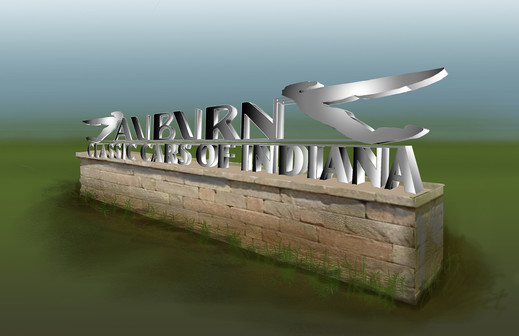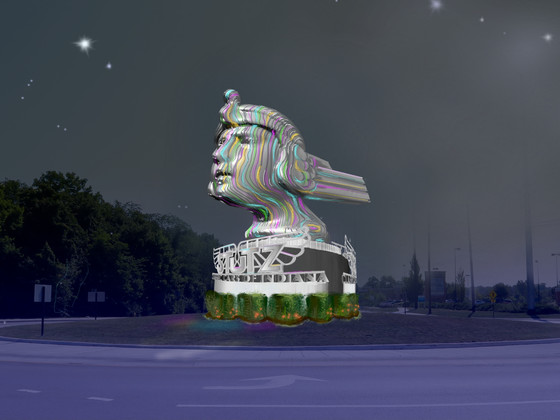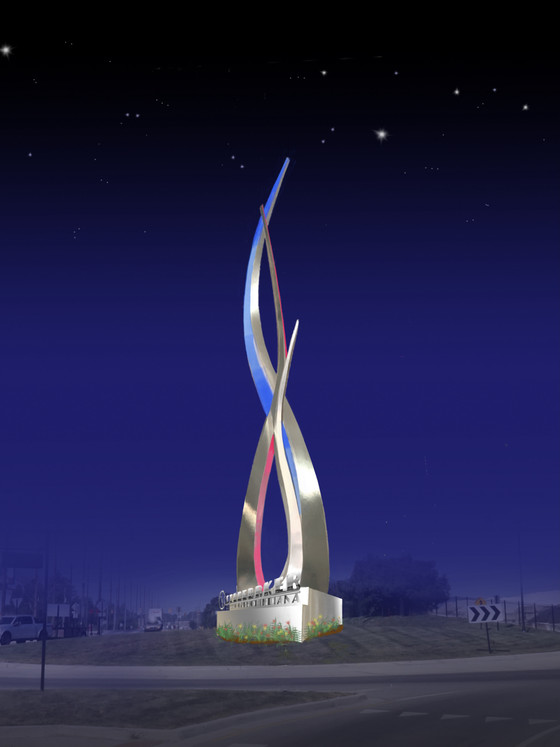Celebrating Indiana’s Classic Cars with 4 New Roundabout Sculptures
The City of Carmel has commissioned four new roundabout sculptures for the 96th Street corridor that will celebrate “Indiana’s Classic Cars.” The new pieces will be designed by the artist Arlon Bayliss and are scheduled to be placed in 2022 and 2023. The four automobile themed sculptures will beautify the new roundabouts on 96th Street at Priority Way, Delegates Row, Gray Road and Hazel Dell Parkway.
The four sculptures will feature artistic interpretations of the classic cars Marmon, Auburn-Cord-Duesenberg, Stutz and Studebaker – each of which were designed and built in Indiana during the first half of the 20th Century when America first began to fall in love with automobiles.
 “Great public art is an important part of our mission in Carmel to create a City that stands apart for its beauty and quality of life,” said Mayor Jim Brainard. “As this corridor is home to so many automobile dealerships, we felt it would be appropriate to celebrate the beauty and genius of Indiana’s classic cars and the remarkable contributions they made to the industry.
“Great public art is an important part of our mission in Carmel to create a City that stands apart for its beauty and quality of life,” said Mayor Jim Brainard. “As this corridor is home to so many automobile dealerships, we felt it would be appropriate to celebrate the beauty and genius of Indiana’s classic cars and the remarkable contributions they made to the industry.
“The 96th Street corridor is our boundary with Indianapolis and it is important for our tax base that this area continues to thrive. Coming shortly after our investments in creating better traffic flow along this thoroughfare, this project will solidify the 96th Street corridor as the premiere place to shop for and buy cars in the Midwest.”
The cost of the sculptures will be $2.5 million and will be paid out of TIF bonds approved by the Carmel City Council.
In the early 1900’s there were more than 100 automobile manufacturers in Indiana. Many of them are recognized as iconic expressions of invention and ingenuity in the history of the American automobile.
“From the late 1800’s through the first half of the 20th century, an explosion in Hoosier creativity resulted in beautiful and innovative cars. Many car makers pioneered features we take for granted today like front wheel drive, rear view mirrors, and independent suspension,” said Bayliss. “While these sculptures will honor some of the most well-known Indiana Classic Cars. they will not be mere reproductions. Instead, they will be four unique artworks inspired by the beauty and creative genius of these cars.”
Each of the artworks refers to a common theme, however, to echo the variety and creativity seen in Indiana’s Classic Cars, Bayliss has approached each sculpture differently in form and content. One is inspired by an elegant hood ornament, one by the flowing outline drawings of a prolific car designer, one by the world’s most famous race car and another by a celebrated logo design.
Below is a look at each of the sculpture designs.
MARMON at 96th Street and Priority Way
 Arguably, the world’s most famous race car, the Model 32-based, six-cylinder “Marmon Wasp” won the first Indy 500 in 1911. The car’s engineer and driver, Ray Harroun of Anderson, Indiana, pioneered an aerodynamic tail and the first known use of a rearview mirror, an invention that eliminated the need for a mechanic to ride along and warn the driver of approaching cars. The original car survives and is a priceless gem in the Indianapolis Motor Speedway Museum collection. A photograph taken at the time of the race famously distorted the car so that its form slants forward, emphasizing speed. Affectionately known by the museum staff as the “wonky wheel wasp photo,” it most likely inspired artwork for the latter of two U.S. postage stamps that celebrate this unique, historic vehicle.MARMON at 96th Street and Priority Way
Arguably, the world’s most famous race car, the Model 32-based, six-cylinder “Marmon Wasp” won the first Indy 500 in 1911. The car’s engineer and driver, Ray Harroun of Anderson, Indiana, pioneered an aerodynamic tail and the first known use of a rearview mirror, an invention that eliminated the need for a mechanic to ride along and warn the driver of approaching cars. The original car survives and is a priceless gem in the Indianapolis Motor Speedway Museum collection. A photograph taken at the time of the race famously distorted the car so that its form slants forward, emphasizing speed. Affectionately known by the museum staff as the “wonky wheel wasp photo,” it most likely inspired artwork for the latter of two U.S. postage stamps that celebrate this unique, historic vehicle.MARMON at 96th Street and Priority Way
The abstracted sculpture of the vehicle slants dynamically forward. To further emphasize speed, the open-framed artwork is lifted, sitting only on its rear wheels, so that the front wheels rise off the sculpture pedestal. The rectangular base is finished in Indiana limestone and brick, a nod to the famous Brickyard racetrack. Limestone inset panels on each long side frame custom signage. The base’s sloping sides raise the sculpture more than five feet above grade, protecting the artwork and enabling it to be viewed clearly. The sculpture and base together will measure around 25 feet long and more than 12 feet high. Like the Marmon Wasp, the sculpture will be painted yellow and black, its powder-coated framework will be illuminated at night.
AUBURN, CORD, DUESENBERG at 96th Street and Delegates Way
 The contributions these three car companies made to car design is impossible to overstate. Managed together in their most fruitful years under the creative leadership of E.L.Cord, Auburn and Duesenberg produced their best cars. Cord encouraged the two makers to improve further on their strengths and in 1929 started a third, highly innovative car company, “Cord.”
The contributions these three car companies made to car design is impossible to overstate. Managed together in their most fruitful years under the creative leadership of E.L.Cord, Auburn and Duesenberg produced their best cars. Cord encouraged the two makers to improve further on their strengths and in 1929 started a third, highly innovative car company, “Cord.”
AUBURN – The art deco influenced 851 Boattail Speedster was the first stock American car guaranteed to exceed 100 miles per hour in stock form. Its performance was astonishing, but the car is remembered today for its styling; clearly, one of the most beautiful and unforgettable designs of the 1930s.
CORD – Basking in American prosperity of the late 1920s, entrepreneur, E. L. Cord launched an exciting and innovative high-performance luxury car bearing his name. The Cord 810 caused a sensation at the New York Auto Show in November 1935. Among other advances, Cord pioneered front wheel drive, concealed headlights and the steering mounted horn.
DUESENBERG – Quite possibly the most valuable American production cars in history, these powerful prestigious cars, were owned by the rich and famous, like Hollywood stars Gary Cooper and Clark Gable. The Duesenberg SSJ was the fastest pre-World War II production road car by a considerable margin and would outrun an Aston Martin DB5 or Mercedes Gullwing produced two decades later. One previously owned by Cooper recently sold for $22 million at public auction.
For the sculpture, Bayliss discovered that one designer, Gordon Beuhrig, was responsible for developing the most well-known cars for all three companies. Such were his ground-breaking ideas, innovations and beautiful designs that he later became known as “the dean of classic automobile design.” His Duesenberg Model J, Cord 810 and Auburn Boattail Speedster revolutionized automotive design; the Cord was selected by The Museum of Modern Art as one of the most influential car designs of all time.
Inspired by Beuhrig’s drawings, the sculpture features silhouettes of famous Auburn, Cord and Duesenbergs. Arranged on three curved stems and tapering like feathers they ascend towards a star-shaped “star-of achievement.” From the “boat tail” inspired star, mounted on slim stems, burst gears, pistons and wheels, symbols of the companies’ engineering innovations. At night, the 32-foot-high sculpture is illuminated by LED spotlights. Its crown and symbols feature multi-colored sparkling dichroic lighting, similar to the artist’s first commission for Carmel, “Beacon Bloom.”
STUTZ at 96th Street and Gray Road
 One of the great Jazz Age American sports cars, the Stutz Bearcat, was a prized champion of early automobile racing. Stutz invented the transaxle and developed an “underslung chassis,” an invention still in use today that greatly enhances the safety and stability of motor vehicles. To emphasize its safety focus and resonate with an interest in Egyptology that swept the country in the early 1920s, Stutz chose the Egyptian sun god, Ra, for its radiator mascot or hood ornament. Ra, who symbolized strength and security, was created by Aurelius Marcus Bennetti and Dee Carlton Brown. They designed a highly stylized Egyptian god; a beautiful example of Art Deco. Ra graced the radiators of Stutz models from 1925 to 1935.
One of the great Jazz Age American sports cars, the Stutz Bearcat, was a prized champion of early automobile racing. Stutz invented the transaxle and developed an “underslung chassis,” an invention still in use today that greatly enhances the safety and stability of motor vehicles. To emphasize its safety focus and resonate with an interest in Egyptology that swept the country in the early 1920s, Stutz chose the Egyptian sun god, Ra, for its radiator mascot or hood ornament. Ra, who symbolized strength and security, was created by Aurelius Marcus Bennetti and Dee Carlton Brown. They designed a highly stylized Egyptian god; a beautiful example of Art Deco. Ra graced the radiators of Stutz models from 1925 to 1935.
Inspired by the Stutz “Ra” Art Deco hood ornament, this sculpture enlarges the head to around 16 feet high. It will be elevated on a five-foot-high Indiana limestone base. Using dozens of sheets of steel, the head is sculpted in vertical slices with spaces between them, creating an ethereal light-permeable abstract form. At night the artwork is illuminated from within using the artists signature-colored dichroic-filtered light sources.
STUDEBAKER at 96th Street and Hazel Dell Parkway
 Studebaker produced vehicles for more than 100 years, from horse drawn carts to electric vehicles, military vehicles to gas vehicles. The car maker contracted with world famous designer Raymond Loewy whose team produced many ground-breaking designs including the Hawk and Avanti. One of their Studebaker logo designs became a mid-century design classic known as the lazy “S.”
Studebaker produced vehicles for more than 100 years, from horse drawn carts to electric vehicles, military vehicles to gas vehicles. The car maker contracted with world famous designer Raymond Loewy whose team produced many ground-breaking designs including the Hawk and Avanti. One of their Studebaker logo designs became a mid-century design classic known as the lazy “S.”
